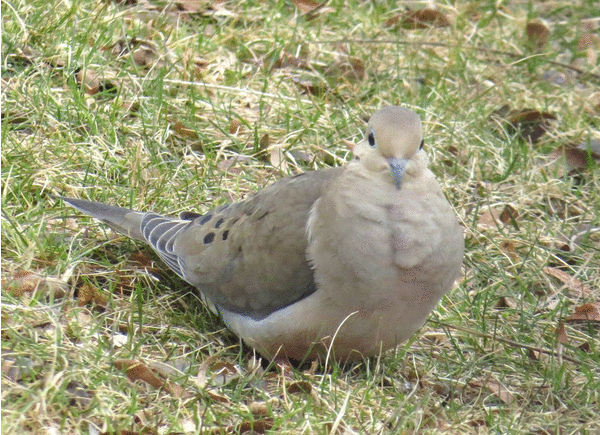
No matter how serious you are about birding, or how much you want to see hawks, a Mourning Dove will always have a stronger interest in spotting them. Birds that are in mortal danger of hawk attacks have excellent eyesight and are constantly alert to any potential threat. It’s a safe bet that they will spot any hawk well before you do.
When a bird wants to get a better view of something, it usually won’t turn to face directly at the thing, instead it will turn its head sideways to look with one eye. Paying attention to these sideways glances can help you locate a lot of hawks.
It’s possible that this dove is using its right eye to take a close look at something on its back, but more likely it is using its left eye and looking at something up in the sky. We should turn to look up about 45 degrees and behind our right shoulder.
If you are seeing just a single bird like this, and it’s making just a casual glance up at the sky, then chances are there is nothing significant up there. It might be a passing goldfinch, or a dandelion seed floating by, or countless other possibilities. But if you are watching a group of birds, such as a flock of shorebirds or geese, and they all start glancing up in the same direction, there’s a very good chance that a predator is up there.
Other clues in this dove’s body language can help to tell us what it is seeing. This Mourning Dove looks pretty relaxed in general – the head is upright and pulled back over the shoulders, the neck and body feathers are fluffed out – it doesn’t seem to be feeling any stress. So it’s probably seeing something more like a dandelion seed, and not really worth it for us to look up at the sky.
If the dove was seeing a hawk we would notice a slight tensing of its posture – body feathers compressed, head down and forward, holding still except for turning its head – and then it would be worth looking very carefully for a hawk. And if, at the same time, the chickadees and finches around the feeder became silent and still, we could be almost certain that a hawk was in view, somewhere.


Pingback: Blog Birding #233 « ABA Blog
City Rock Pigeons can separate an adult female Cooper’s Hawk from a Red tailed Hawk
with just a glance. My office looks out on a dirt / gravel parking lot next door and there is usually a large puddle of rainwater on one edge. There are frequently several Pigeons drinking or resting on the wires near by. We have a resident Cooper’s Hawk that puts in a regular appearance and I have seen it nail three Pigeons in the last year. Usually when it is around the Pigeons leave in a hurry. There is also a Red Tailed Hawk that hangs around. The other day it came cruising in and landed on one of the Telephone poles. There were three pigeons on the wire 15 feet away and they never moved. There were 5-6 Pigeons on the ground at the puddle and they didn’t fly. Good identification skills on display.
I still worry about my mourning doves; I used to hear
& see them on wires out in in open morning & evening
one quite regularly; the mate seemed to have disappeared.
Now, October, no mourning doves; just hope they have migrated south & I think, but not certain they did not not migrate south previous years.